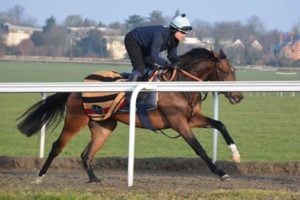They say there are many ways to skin a cat. As it turns out, there are many ways to become a jockey too.
While the SA Jockey Academy is the traditional tried and tested route for local aspirants, there are a few other options for those brave enough to explore them. Someone who has made it happen, is Skye Gilbert, who had her first race under rules at Scottsville on Wednesday, 1 February 2017, piloting Just Rap for Des Egdes in race 6 on the afternoon’s card. She rode an accomplished race to finish 4.2 lengths off.
Skye is the daughter of well-known KZN show-jumper and eventer, Kim Egdes (now married to KZN trainer Des Egdes) and Cape farrier, Ford Wallace. Having grown up with a strong horsey background, Skye says she always wanted to be a jockey, but couldn’t get into the SA Jockey Academy as she wasn’t quite small enough and because her parents wanted her to finish her education first.
After school, she took a gap year and went to England, basing herself with her aunt in Newmarket. She applied for and got a work rider job with Marco Botti, working for him for 8 months before going to work on a private stud for a year.
Being in the right place at the right time
“A friend of mine is the head lass at Ed Dunlop’s yard and said they were looking for staff. I went on a trial and got the job!” Skye moved to Ed Dunlop about a year and a half ago and in her own words, ‘just started doing more and more.” She eventually approached him about taking out her apprentice license. “It works differently there. The trainer needs to apply for you through his yard and then he’s responsible for you. I went on the course and then my license came through in November. I have an unrestricted license there, not like here where an apprentice has to have their first rides down the straight.”
Becoming a jockey
As someone who harboured similar ambitions many years (and quite a few kilo’s) ago, it’s difficult not to be slightly envious. How did she do it? “The SA Academy requires you to be 45kgs or less to get in, which just wasn’t possible for me and if you want to finish your education first as I did, that also makes things tricky. I had given up on the idea completely and didn’t think there was any chance of making it, but it works quite differently in England. You need to get experience and learn to work with horses before you apply. Then you need a trainer that’s willing to apply and go through the process for you which is also tricky. And you have to be under the age of 23 to apply. I turned 24 last week, so I got in just in time.”
Having gained sufficient experience, aspirant candidates then need to attend an apprentice license course. “It’s a course to assess you fitness-wise and riding-wise. You jump through the stalls and ride work on different kinds of horses with different temperaments. They also test you on the rules of racing, so you have to know every side of it. Then they either grant you your license or a restricted license, depending on your assessment.” Skye completed her course through the British Racing School in Newmarket. “You stay on the premises and the course is all sponsored. Your trainers applies on your behalf, so the application fee is paid by the trainer and there is a fund that subsidises the course fee. The course is only held 3 or 4 times a year and they only accept a certain number of people. We had 8 on our intake.”
Different focus
“Although the main focus is your riding ability, they do ask for your weight and you need to be 8st 3lbs with your kit. I did have to lose some weight to make it, and got to 8st for my weigh in, so I was 8st 3lbs with my riding stuff.” Interestingly, they are less focussed on height. “Joseph O’Brien is quite tall and he was very successful. Being tall just means your career might be short-lived, but you can still do well in that amount of time.”
It is interesting to hear her being so matter of fact about it. “People tend to think there are only two options in racing – you’re either a jockey or a trainer (or a jockey and then a trainer), but there are so many different careers in racing after being a jockey. You can study anything – nutrition, physiotherapy, personal training, become a racing secretary or go into the stud side of things – there are many options.” In fact, there is even a fund (named JETS – Jockeys Employment & Training Scheme) dedicated to helping prepare jockeys for second careers.” Skye explains that similar to the SA system, she will also start out with an apprentice allowance of 7lbs, which she will shed as she accumulates wins and once she reaches 95 wins, she will be considered a professional jockey. “It’s a lot more difficult to get rides and winners there then here. Apprentices are quite lucky here, they do get rides and do get used a lot. It’s a lot more difficult in England, so I’m very lucky to be with Ed Dunlop.”
Daily Routine
For now, Skye’s routine is much the same. Work starts at 5:30 and riders are expected to tack up their own horses, walk them to the heath, exercise them, trot them, bring them back, brush and feed every horse they ride. Riding and yard work finishes by around 12 after which it’s home for lunch and then off to the gym at 2pm, where there is an equiciser to practice on. Then it’s back to work for evening stables where horses are skipped out, groomed, fed and watered and that takes them through to 5:30 / 6pm.
One of the most striking things about Newmarket is how beautifully all the horses and riders are turned out. Tack is spotless, riders all have polished leather boots and the horses would not look out of place in a showing class. Each string works together as a unit and is easily identifiable from their tack and how the riders are dressed. Skye explains, “In summer you put quarter marks on every horse you ride. Everyone takes real pride in themselves and their horses and takes a lot of pride in their job. Riding is a big part of the industry there and people work very hard. Being a groom / rider is considered a career there.”
What is it like living and working in the racing capital of the world? “I cannot handle winter – it’s tough! With the ice and the snow, it’s just so cold and I do battle, but other than that, it’s great. Everyone gets on really well and it’s a great team. Everyone in town knows each other and it’s a lot of fun. The whole in industry is just racing, racing, racing.”
The X factor
Is there any difference / difficulty being a girl? “On my course there were 4 girls and 4 guys which is great. There are a lot more women jockeys over there and the numbers are increasing as the years go by. We’ve got Hayley Turner showing that we can do it and in our year, Josephine Gordon was champion apprentice, so that’s great for us girls.” Is it a career path she would recommend for girls? “I would recommend it if you are very determined. You have to be passionate. It takes a lot of work, fitness, eating well – all your time goes into it – but I think it will be worthwhile to achieve my dream and it’s been an achievement to get this far.” What about the obvious question about family and children? “I would like to have my own family eventually, but for now I want to give it all I have and see where I can go. I think you have to set that limit and reassess in a few years time. You can get a good few years out of it, so I think rather go for it now and have children later on.”
How was her first ride under rules?
“I loved it, it was a great experience,” she enthuses. “I couldn’t have had a better ride and I must give a shout out to my step father, Des Egdes for the ride! It was extremely hot and I did a very light weight on the day as well, so I did get tired. I’m quite fit cardio-wise, but race riding is a whole different ballgame and one can only improve your fitness by race riding. But otherwise I think I handled it well. I’m glad to get the first one out of the way! It was good experience and hopefully I can build on that.”
How was she received in the jockey room? “The local guys were great and professional, but helpful. Luckily I’ve known most of them since I was young, so they were all really helpful and supportive.”
Asked to talk me through the race, Skye says, “We broke quite well. I gave the filly a tap on the shoulder as I knew they would be going quite quick. It’s a bit short for her, so I got her settled 3 or 4 lengths off. I thought I might need to get her going slightly earlier as there’s a bit of a hill coming into the finish at Scottsville and she showed a turn of foot and stayed on well. She could do with further next time, they were just quite quick for her and it was a strong field.”
“I loved it, I really did. I think it helped that I was drawn wide as I wasn’t really in the middle of it and could sit on the outskirts and think about it. I think I had the best experience for a first time. I think the idea to give apprentices 5 rides down the straight is a really good one. It would be overwhelming to go round the bend first time out in a full field.”
Future
Skye heads back to the UK on 13 February and then it will be straight back to work. “It will be back to work, get fit and get back into it. If I can, I’d like to start riding out for a few other trainers to get more experience and hopefully get some more rides. We’ll be coming to the end of the all weather season so hopefully I can get going when the turf season starts and hopefully Ed will support me with a few rides.”











